Understanding Business Organisations and Their Environments
VerifiedAdded on 2023/06/18
|7
|2004
|373
AI Summary
This report provides an in-depth understanding of various types of business structures, tall and flat organizational structures, business functions, and the impact of positive organizational culture on the success of the organization. The primary organization considered in this report is Unilever, a UK-based multinational organization that deals in consumer goods.
Contribute Materials
Your contribution can guide someone’s learning journey. Share your
documents today.
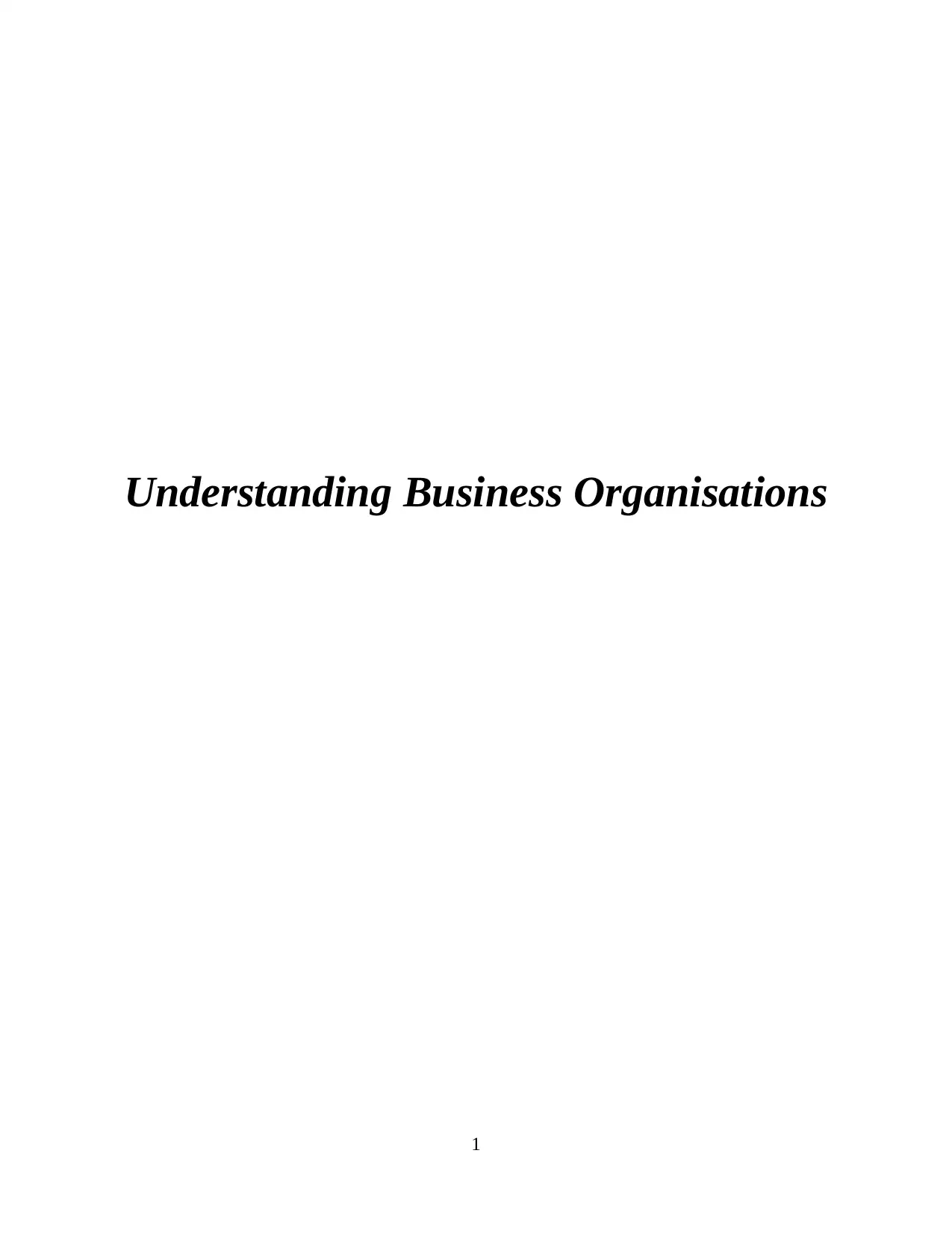
Understanding Business Organisations
1
1
Secure Best Marks with AI Grader
Need help grading? Try our AI Grader for instant feedback on your assignments.
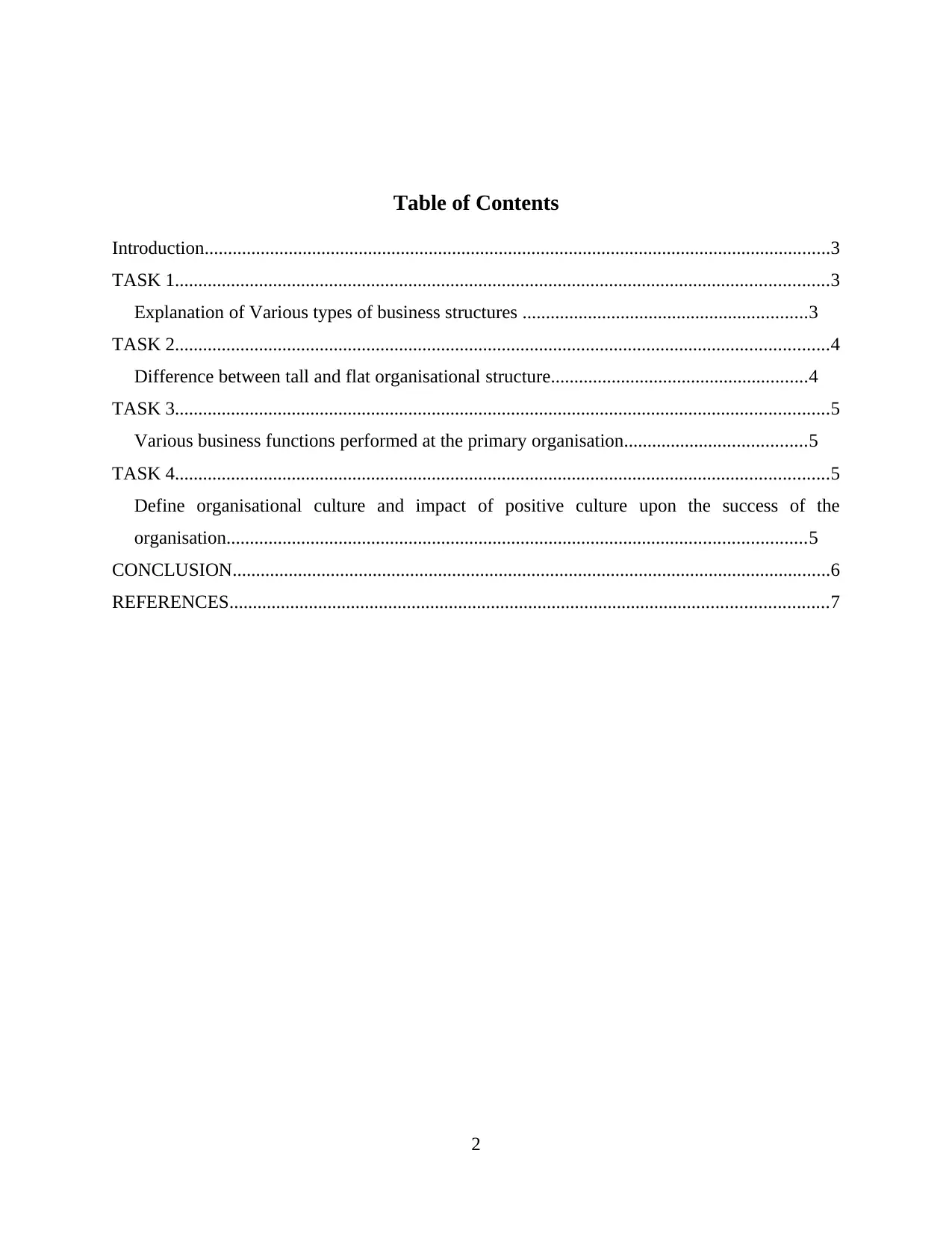
Table of Contents
Introduction......................................................................................................................................3
TASK 1............................................................................................................................................3
Explanation of Various types of business structures .............................................................3
TASK 2............................................................................................................................................4
Difference between tall and flat organisational structure.......................................................4
TASK 3............................................................................................................................................5
Various business functions performed at the primary organisation.......................................5
TASK 4............................................................................................................................................5
Define organisational culture and impact of positive culture upon the success of the
organisation............................................................................................................................5
CONCLUSION................................................................................................................................6
REFERENCES................................................................................................................................7
2
Introduction......................................................................................................................................3
TASK 1............................................................................................................................................3
Explanation of Various types of business structures .............................................................3
TASK 2............................................................................................................................................4
Difference between tall and flat organisational structure.......................................................4
TASK 3............................................................................................................................................5
Various business functions performed at the primary organisation.......................................5
TASK 4............................................................................................................................................5
Define organisational culture and impact of positive culture upon the success of the
organisation............................................................................................................................5
CONCLUSION................................................................................................................................6
REFERENCES................................................................................................................................7
2
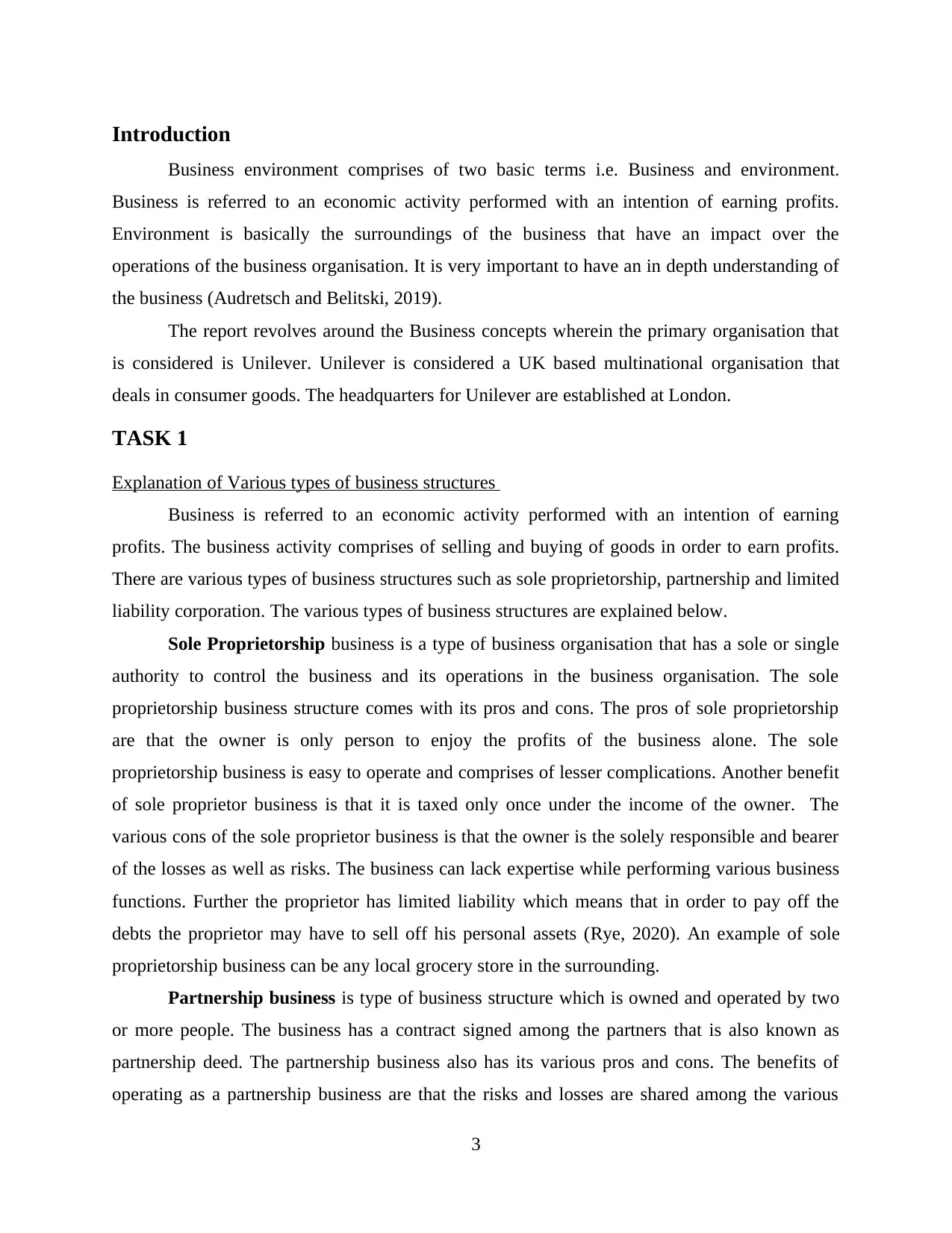
Introduction
Business environment comprises of two basic terms i.e. Business and environment.
Business is referred to an economic activity performed with an intention of earning profits.
Environment is basically the surroundings of the business that have an impact over the
operations of the business organisation. It is very important to have an in depth understanding of
the business (Audretsch and Belitski, 2019).
The report revolves around the Business concepts wherein the primary organisation that
is considered is Unilever. Unilever is considered a UK based multinational organisation that
deals in consumer goods. The headquarters for Unilever are established at London.
TASK 1
Explanation of Various types of business structures
Business is referred to an economic activity performed with an intention of earning
profits. The business activity comprises of selling and buying of goods in order to earn profits.
There are various types of business structures such as sole proprietorship, partnership and limited
liability corporation. The various types of business structures are explained below.
Sole Proprietorship business is a type of business organisation that has a sole or single
authority to control the business and its operations in the business organisation. The sole
proprietorship business structure comes with its pros and cons. The pros of sole proprietorship
are that the owner is only person to enjoy the profits of the business alone. The sole
proprietorship business is easy to operate and comprises of lesser complications. Another benefit
of sole proprietor business is that it is taxed only once under the income of the owner. The
various cons of the sole proprietor business is that the owner is the solely responsible and bearer
of the losses as well as risks. The business can lack expertise while performing various business
functions. Further the proprietor has limited liability which means that in order to pay off the
debts the proprietor may have to sell off his personal assets (Rye, 2020). An example of sole
proprietorship business can be any local grocery store in the surrounding.
Partnership business is type of business structure which is owned and operated by two
or more people. The business has a contract signed among the partners that is also known as
partnership deed. The partnership business also has its various pros and cons. The benefits of
operating as a partnership business are that the risks and losses are shared among the various
3
Business environment comprises of two basic terms i.e. Business and environment.
Business is referred to an economic activity performed with an intention of earning profits.
Environment is basically the surroundings of the business that have an impact over the
operations of the business organisation. It is very important to have an in depth understanding of
the business (Audretsch and Belitski, 2019).
The report revolves around the Business concepts wherein the primary organisation that
is considered is Unilever. Unilever is considered a UK based multinational organisation that
deals in consumer goods. The headquarters for Unilever are established at London.
TASK 1
Explanation of Various types of business structures
Business is referred to an economic activity performed with an intention of earning
profits. The business activity comprises of selling and buying of goods in order to earn profits.
There are various types of business structures such as sole proprietorship, partnership and limited
liability corporation. The various types of business structures are explained below.
Sole Proprietorship business is a type of business organisation that has a sole or single
authority to control the business and its operations in the business organisation. The sole
proprietorship business structure comes with its pros and cons. The pros of sole proprietorship
are that the owner is only person to enjoy the profits of the business alone. The sole
proprietorship business is easy to operate and comprises of lesser complications. Another benefit
of sole proprietor business is that it is taxed only once under the income of the owner. The
various cons of the sole proprietor business is that the owner is the solely responsible and bearer
of the losses as well as risks. The business can lack expertise while performing various business
functions. Further the proprietor has limited liability which means that in order to pay off the
debts the proprietor may have to sell off his personal assets (Rye, 2020). An example of sole
proprietorship business can be any local grocery store in the surrounding.
Partnership business is type of business structure which is owned and operated by two
or more people. The business has a contract signed among the partners that is also known as
partnership deed. The partnership business also has its various pros and cons. The benefits of
operating as a partnership business are that the risks and losses are shared among the various
3
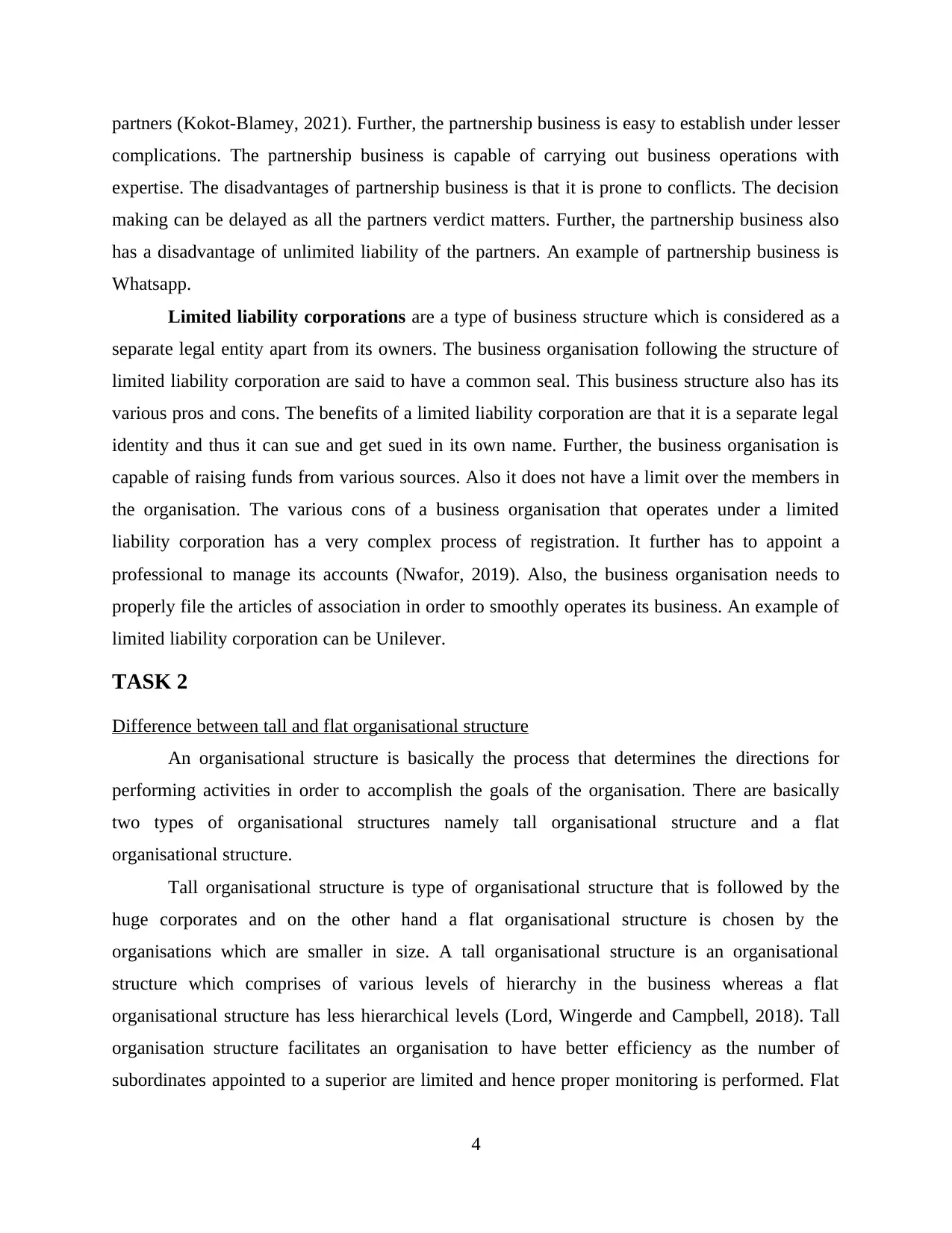
partners (Kokot-Blamey, 2021). Further, the partnership business is easy to establish under lesser
complications. The partnership business is capable of carrying out business operations with
expertise. The disadvantages of partnership business is that it is prone to conflicts. The decision
making can be delayed as all the partners verdict matters. Further, the partnership business also
has a disadvantage of unlimited liability of the partners. An example of partnership business is
Whatsapp.
Limited liability corporations are a type of business structure which is considered as a
separate legal entity apart from its owners. The business organisation following the structure of
limited liability corporation are said to have a common seal. This business structure also has its
various pros and cons. The benefits of a limited liability corporation are that it is a separate legal
identity and thus it can sue and get sued in its own name. Further, the business organisation is
capable of raising funds from various sources. Also it does not have a limit over the members in
the organisation. The various cons of a business organisation that operates under a limited
liability corporation has a very complex process of registration. It further has to appoint a
professional to manage its accounts (Nwafor, 2019). Also, the business organisation needs to
properly file the articles of association in order to smoothly operates its business. An example of
limited liability corporation can be Unilever.
TASK 2
Difference between tall and flat organisational structure
An organisational structure is basically the process that determines the directions for
performing activities in order to accomplish the goals of the organisation. There are basically
two types of organisational structures namely tall organisational structure and a flat
organisational structure.
Tall organisational structure is type of organisational structure that is followed by the
huge corporates and on the other hand a flat organisational structure is chosen by the
organisations which are smaller in size. A tall organisational structure is an organisational
structure which comprises of various levels of hierarchy in the business whereas a flat
organisational structure has less hierarchical levels (Lord, Wingerde and Campbell, 2018). Tall
organisation structure facilitates an organisation to have better efficiency as the number of
subordinates appointed to a superior are limited and hence proper monitoring is performed. Flat
4
complications. The partnership business is capable of carrying out business operations with
expertise. The disadvantages of partnership business is that it is prone to conflicts. The decision
making can be delayed as all the partners verdict matters. Further, the partnership business also
has a disadvantage of unlimited liability of the partners. An example of partnership business is
Whatsapp.
Limited liability corporations are a type of business structure which is considered as a
separate legal entity apart from its owners. The business organisation following the structure of
limited liability corporation are said to have a common seal. This business structure also has its
various pros and cons. The benefits of a limited liability corporation are that it is a separate legal
identity and thus it can sue and get sued in its own name. Further, the business organisation is
capable of raising funds from various sources. Also it does not have a limit over the members in
the organisation. The various cons of a business organisation that operates under a limited
liability corporation has a very complex process of registration. It further has to appoint a
professional to manage its accounts (Nwafor, 2019). Also, the business organisation needs to
properly file the articles of association in order to smoothly operates its business. An example of
limited liability corporation can be Unilever.
TASK 2
Difference between tall and flat organisational structure
An organisational structure is basically the process that determines the directions for
performing activities in order to accomplish the goals of the organisation. There are basically
two types of organisational structures namely tall organisational structure and a flat
organisational structure.
Tall organisational structure is type of organisational structure that is followed by the
huge corporates and on the other hand a flat organisational structure is chosen by the
organisations which are smaller in size. A tall organisational structure is an organisational
structure which comprises of various levels of hierarchy in the business whereas a flat
organisational structure has less hierarchical levels (Lord, Wingerde and Campbell, 2018). Tall
organisation structure facilitates an organisation to have better efficiency as the number of
subordinates appointed to a superior are limited and hence proper monitoring is performed. Flat
4
Secure Best Marks with AI Grader
Need help grading? Try our AI Grader for instant feedback on your assignments.
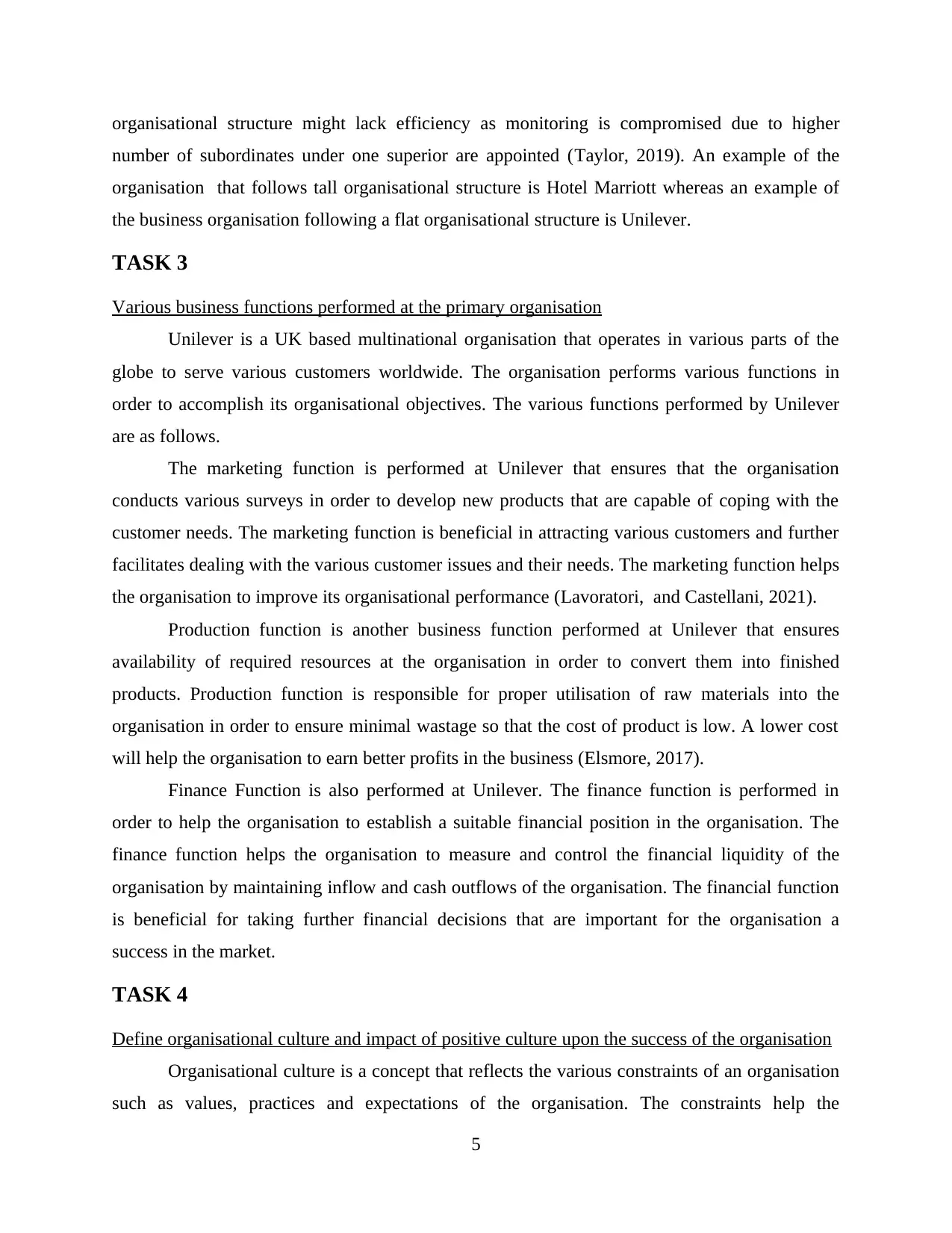
organisational structure might lack efficiency as monitoring is compromised due to higher
number of subordinates under one superior are appointed (Taylor, 2019). An example of the
organisation that follows tall organisational structure is Hotel Marriott whereas an example of
the business organisation following a flat organisational structure is Unilever.
TASK 3
Various business functions performed at the primary organisation
Unilever is a UK based multinational organisation that operates in various parts of the
globe to serve various customers worldwide. The organisation performs various functions in
order to accomplish its organisational objectives. The various functions performed by Unilever
are as follows.
The marketing function is performed at Unilever that ensures that the organisation
conducts various surveys in order to develop new products that are capable of coping with the
customer needs. The marketing function is beneficial in attracting various customers and further
facilitates dealing with the various customer issues and their needs. The marketing function helps
the organisation to improve its organisational performance (Lavoratori, and Castellani, 2021).
Production function is another business function performed at Unilever that ensures
availability of required resources at the organisation in order to convert them into finished
products. Production function is responsible for proper utilisation of raw materials into the
organisation in order to ensure minimal wastage so that the cost of product is low. A lower cost
will help the organisation to earn better profits in the business (Elsmore, 2017).
Finance Function is also performed at Unilever. The finance function is performed in
order to help the organisation to establish a suitable financial position in the organisation. The
finance function helps the organisation to measure and control the financial liquidity of the
organisation by maintaining inflow and cash outflows of the organisation. The financial function
is beneficial for taking further financial decisions that are important for the organisation a
success in the market.
TASK 4
Define organisational culture and impact of positive culture upon the success of the organisation
Organisational culture is a concept that reflects the various constraints of an organisation
such as values, practices and expectations of the organisation. The constraints help the
5
number of subordinates under one superior are appointed (Taylor, 2019). An example of the
organisation that follows tall organisational structure is Hotel Marriott whereas an example of
the business organisation following a flat organisational structure is Unilever.
TASK 3
Various business functions performed at the primary organisation
Unilever is a UK based multinational organisation that operates in various parts of the
globe to serve various customers worldwide. The organisation performs various functions in
order to accomplish its organisational objectives. The various functions performed by Unilever
are as follows.
The marketing function is performed at Unilever that ensures that the organisation
conducts various surveys in order to develop new products that are capable of coping with the
customer needs. The marketing function is beneficial in attracting various customers and further
facilitates dealing with the various customer issues and their needs. The marketing function helps
the organisation to improve its organisational performance (Lavoratori, and Castellani, 2021).
Production function is another business function performed at Unilever that ensures
availability of required resources at the organisation in order to convert them into finished
products. Production function is responsible for proper utilisation of raw materials into the
organisation in order to ensure minimal wastage so that the cost of product is low. A lower cost
will help the organisation to earn better profits in the business (Elsmore, 2017).
Finance Function is also performed at Unilever. The finance function is performed in
order to help the organisation to establish a suitable financial position in the organisation. The
finance function helps the organisation to measure and control the financial liquidity of the
organisation by maintaining inflow and cash outflows of the organisation. The financial function
is beneficial for taking further financial decisions that are important for the organisation a
success in the market.
TASK 4
Define organisational culture and impact of positive culture upon the success of the organisation
Organisational culture is a concept that reflects the various constraints of an organisation
such as values, practices and expectations of the organisation. The constraints help the
5
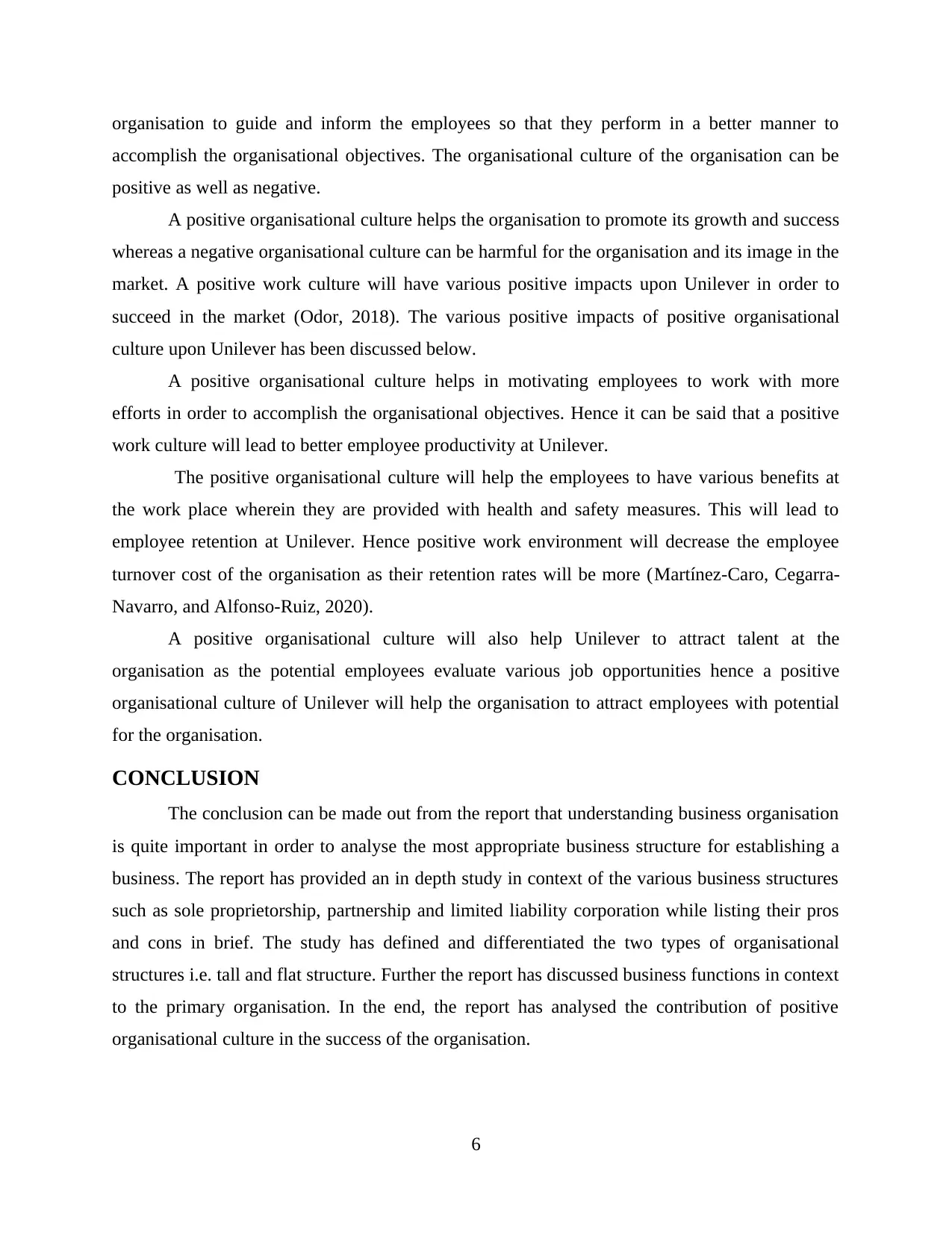
organisation to guide and inform the employees so that they perform in a better manner to
accomplish the organisational objectives. The organisational culture of the organisation can be
positive as well as negative.
A positive organisational culture helps the organisation to promote its growth and success
whereas a negative organisational culture can be harmful for the organisation and its image in the
market. A positive work culture will have various positive impacts upon Unilever in order to
succeed in the market (Odor, 2018). The various positive impacts of positive organisational
culture upon Unilever has been discussed below.
A positive organisational culture helps in motivating employees to work with more
efforts in order to accomplish the organisational objectives. Hence it can be said that a positive
work culture will lead to better employee productivity at Unilever.
The positive organisational culture will help the employees to have various benefits at
the work place wherein they are provided with health and safety measures. This will lead to
employee retention at Unilever. Hence positive work environment will decrease the employee
turnover cost of the organisation as their retention rates will be more (Martínez-Caro, Cegarra-
Navarro, and Alfonso-Ruiz, 2020).
A positive organisational culture will also help Unilever to attract talent at the
organisation as the potential employees evaluate various job opportunities hence a positive
organisational culture of Unilever will help the organisation to attract employees with potential
for the organisation.
CONCLUSION
The conclusion can be made out from the report that understanding business organisation
is quite important in order to analyse the most appropriate business structure for establishing a
business. The report has provided an in depth study in context of the various business structures
such as sole proprietorship, partnership and limited liability corporation while listing their pros
and cons in brief. The study has defined and differentiated the two types of organisational
structures i.e. tall and flat structure. Further the report has discussed business functions in context
to the primary organisation. In the end, the report has analysed the contribution of positive
organisational culture in the success of the organisation.
6
accomplish the organisational objectives. The organisational culture of the organisation can be
positive as well as negative.
A positive organisational culture helps the organisation to promote its growth and success
whereas a negative organisational culture can be harmful for the organisation and its image in the
market. A positive work culture will have various positive impacts upon Unilever in order to
succeed in the market (Odor, 2018). The various positive impacts of positive organisational
culture upon Unilever has been discussed below.
A positive organisational culture helps in motivating employees to work with more
efforts in order to accomplish the organisational objectives. Hence it can be said that a positive
work culture will lead to better employee productivity at Unilever.
The positive organisational culture will help the employees to have various benefits at
the work place wherein they are provided with health and safety measures. This will lead to
employee retention at Unilever. Hence positive work environment will decrease the employee
turnover cost of the organisation as their retention rates will be more (Martínez-Caro, Cegarra-
Navarro, and Alfonso-Ruiz, 2020).
A positive organisational culture will also help Unilever to attract talent at the
organisation as the potential employees evaluate various job opportunities hence a positive
organisational culture of Unilever will help the organisation to attract employees with potential
for the organisation.
CONCLUSION
The conclusion can be made out from the report that understanding business organisation
is quite important in order to analyse the most appropriate business structure for establishing a
business. The report has provided an in depth study in context of the various business structures
such as sole proprietorship, partnership and limited liability corporation while listing their pros
and cons in brief. The study has defined and differentiated the two types of organisational
structures i.e. tall and flat structure. Further the report has discussed business functions in context
to the primary organisation. In the end, the report has analysed the contribution of positive
organisational culture in the success of the organisation.
6
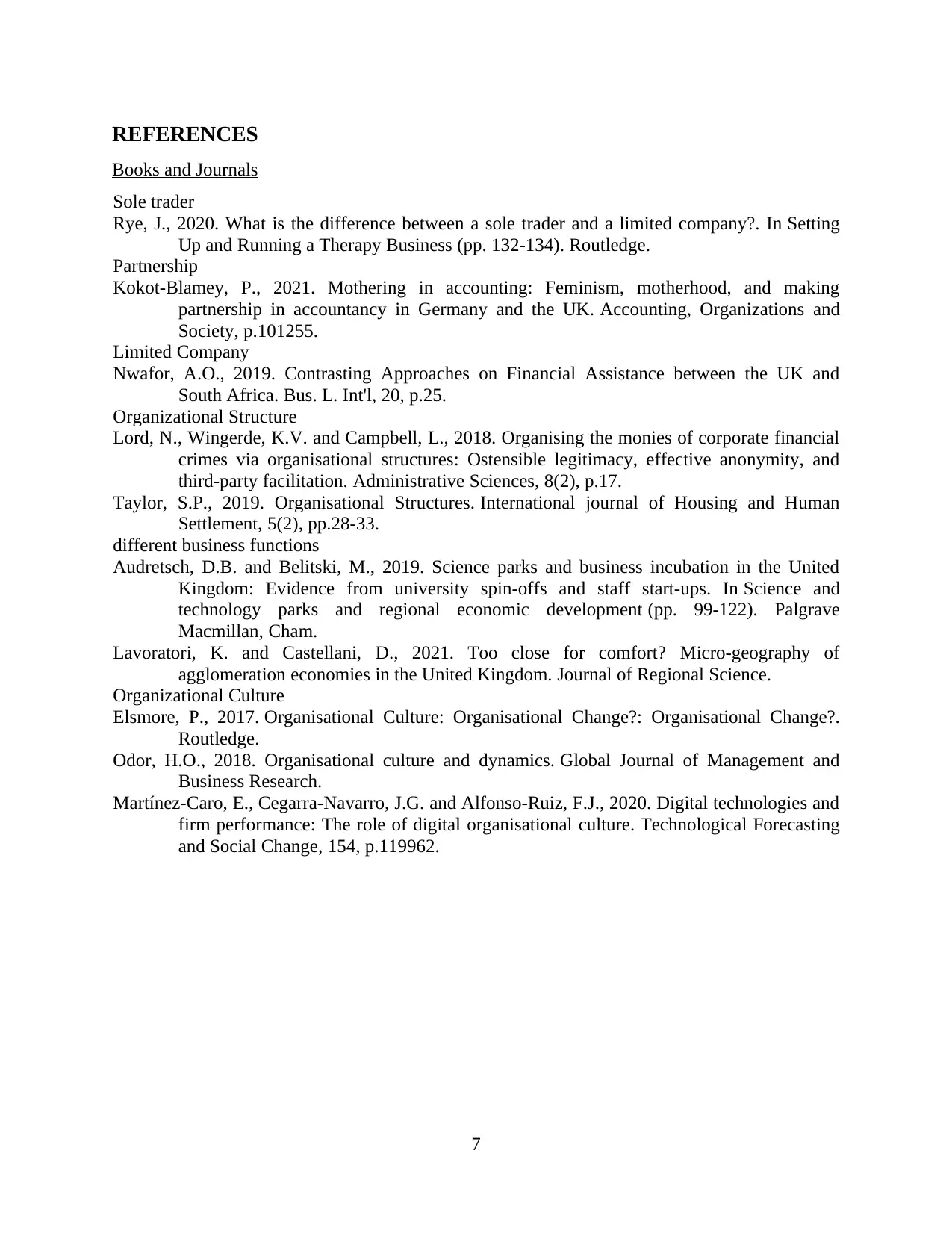
REFERENCES
Books and Journals
Sole trader
Rye, J., 2020. What is the difference between a sole trader and a limited company?. In Setting
Up and Running a Therapy Business (pp. 132-134). Routledge.
Partnership
Kokot-Blamey, P., 2021. Mothering in accounting: Feminism, motherhood, and making
partnership in accountancy in Germany and the UK. Accounting, Organizations and
Society, p.101255.
Limited Company
Nwafor, A.O., 2019. Contrasting Approaches on Financial Assistance between the UK and
South Africa. Bus. L. Int'l, 20, p.25.
Organizational Structure
Lord, N., Wingerde, K.V. and Campbell, L., 2018. Organising the monies of corporate financial
crimes via organisational structures: Ostensible legitimacy, effective anonymity, and
third-party facilitation. Administrative Sciences, 8(2), p.17.
Taylor, S.P., 2019. Organisational Structures. International journal of Housing and Human
Settlement, 5(2), pp.28-33.
different business functions
Audretsch, D.B. and Belitski, M., 2019. Science parks and business incubation in the United
Kingdom: Evidence from university spin-offs and staff start-ups. In Science and
technology parks and regional economic development (pp. 99-122). Palgrave
Macmillan, Cham.
Lavoratori, K. and Castellani, D., 2021. Too close for comfort? Micro‐geography of
agglomeration economies in the United Kingdom. Journal of Regional Science.
Organizational Culture
Elsmore, P., 2017. Organisational Culture: Organisational Change?: Organisational Change?.
Routledge.
Odor, H.O., 2018. Organisational culture and dynamics. Global Journal of Management and
Business Research.
Martínez-Caro, E., Cegarra-Navarro, J.G. and Alfonso-Ruiz, F.J., 2020. Digital technologies and
firm performance: The role of digital organisational culture. Technological Forecasting
and Social Change, 154, p.119962.
7
Books and Journals
Sole trader
Rye, J., 2020. What is the difference between a sole trader and a limited company?. In Setting
Up and Running a Therapy Business (pp. 132-134). Routledge.
Partnership
Kokot-Blamey, P., 2021. Mothering in accounting: Feminism, motherhood, and making
partnership in accountancy in Germany and the UK. Accounting, Organizations and
Society, p.101255.
Limited Company
Nwafor, A.O., 2019. Contrasting Approaches on Financial Assistance between the UK and
South Africa. Bus. L. Int'l, 20, p.25.
Organizational Structure
Lord, N., Wingerde, K.V. and Campbell, L., 2018. Organising the monies of corporate financial
crimes via organisational structures: Ostensible legitimacy, effective anonymity, and
third-party facilitation. Administrative Sciences, 8(2), p.17.
Taylor, S.P., 2019. Organisational Structures. International journal of Housing and Human
Settlement, 5(2), pp.28-33.
different business functions
Audretsch, D.B. and Belitski, M., 2019. Science parks and business incubation in the United
Kingdom: Evidence from university spin-offs and staff start-ups. In Science and
technology parks and regional economic development (pp. 99-122). Palgrave
Macmillan, Cham.
Lavoratori, K. and Castellani, D., 2021. Too close for comfort? Micro‐geography of
agglomeration economies in the United Kingdom. Journal of Regional Science.
Organizational Culture
Elsmore, P., 2017. Organisational Culture: Organisational Change?: Organisational Change?.
Routledge.
Odor, H.O., 2018. Organisational culture and dynamics. Global Journal of Management and
Business Research.
Martínez-Caro, E., Cegarra-Navarro, J.G. and Alfonso-Ruiz, F.J., 2020. Digital technologies and
firm performance: The role of digital organisational culture. Technological Forecasting
and Social Change, 154, p.119962.
7
1 out of 7
Related Documents
Your All-in-One AI-Powered Toolkit for Academic Success.
+13062052269
info@desklib.com
Available 24*7 on WhatsApp / Email
![[object Object]](/_next/static/media/star-bottom.7253800d.svg)
Unlock your academic potential
© 2024 | Zucol Services PVT LTD | All rights reserved.



